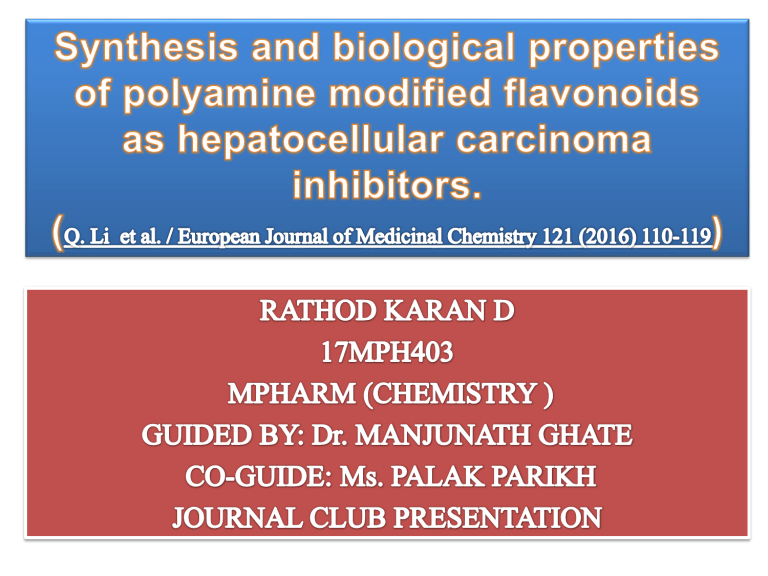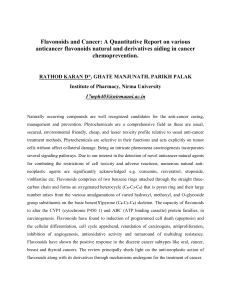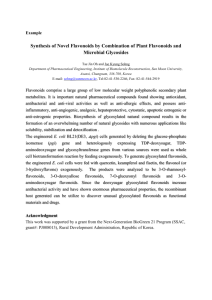17mph403
advertisement

FLAVONOIDS • Flavonoids comprise of a huge group of polyphenolic compounds encompass a benzo-γ-pyrone core moiety. • Chemically flavonoids rely upon a fifteen-carbon skeleton possessing of two benzene rings. • Flavonoids occur in nature as aglycones, glycosides, and methylated derivatives. • Their basic structure is a skeleton of diphenylpropane, namely, two benzene rings (ring A and B) linked by a three carbon chain that forms a closed pyran ring with benzenic A ring. Therefore, their structure is also referred to as C6-C3-C6. HEPATOCELLULAR CARCINOMA • Hepatocellular carcinoma (HCC) is a crucial growth of malignant tumor cell of the liver and takes place mainly in patients with fundamental chronic liver disease and cirrhosis. • The cells of origin are supposed to be the hepatic stem cells, although this remainder the question of examination. • Tumors development progresses with local increase in size, intra-hepatic spread, and outlying metastases. https://emedicine.medscape.com/article/197319-overview SCHEMATIC UNDERSTANDING OF HEPATO CELLULAR CARCINOMA POLYAMINES • Natural polyamines play a essential role in eukaryotic cell growth, division, and proliferation. • Here in the context polyamine stands for the attachment of more than one amine group to the flavonoids nucleus with varying groups attached with the C ring of flavonoids nucleus. • Both indigenous and synthetic polyamines have been attached to varied pharmacophore to provide various biological functions, such as cancer inhibition, neuroprotection, and anti-parasitic properties. • Recently, there is growing interest in the relationship between the polyamines and tumor migration. Q. Li et al. / European Journal of Medicinal Chemistry 121 (2016) 110-119 MAJOR RESEARCH PROBLEM The major research problem depicted is that the authors were likely to assess whether the synthesized polyamine modified flavonoids were able to inhibit the hepatocellular carcinoma. DESCRIPTION • Authors synthesized the series of polyamine conjugates of flavonoids with a naphthalene moiety. • After synthesizing the analogs they evaluated them for their anti-hepatocellular carcinoma attributes with the help of in vitro as well as in vivo assays. • Authors performed the study of the apoptosis on the cell lines at different concentrations assessed by HCS using AO/EB staining on HepG2 cells. • Biological materials and methods – Immuno-fluorescence staining for caspases and p-p38. – In vitro migration assay. – Cellular apoptotic evaluation. – ROS, MMP and LYS/pH staining experiments. – Immuno-fluorescence staining for p53, p-p38, p-JNK, Bcl-2. – Subcutaneous xenograft of H22 cells in Kunming mice. – H22 cells lung metastasis models. SYNTHETIC SCHEME In vitro structure-activity relation study • The ability of the flavonoids to differentiate between cancerous and noncancerous cells was evaluated with an MTT assay. • The two positive controls, Mito (MITOXANTRONE) and Que (QUERCETIN), had contradictory affects in this assay. Mito killed more QSG7701 (noncancerous) cells than the analogous cancerous cells at the equivalent concentration, and Que showed more encouraging cell selectivity. • The cancer cell selectivity of synthesized flavonoids 8a-8d was better to than that of Mito. • Nevertheless, only compound 8a displayed cell type selectivity that resembled to that of Que. In vitro inhibitory rates of novel conjugates NO R, n SMMC 7721(%) HepG2 (%) QSG 7701 (%) 30μM 100μM 30μM 100μM 30μM 100μM 8a (CH2)3NH2 , 2 5.1 87.1 7.9 84.2 <5 41.8 8b (CH2)4 NH2 , 2 <5 39.8 <5 16.1 <5 10.6 8c (CH2)3NH(CH2)4 (CH2)3NH2 , 3 7.6 32.5 <5 28.9 <5 22.4 8d (CH2)4NH(CH2)4 (CH2)3NH2 , 3 70.2 85.5 62.0 75.9 46.7 79.4 8e (CH2)2 N(CH3)3, 2 <5 16.6 <5 7.5 <5 17.9 8f (CH2)2 CH3, 1 14.6 28.4 6.0 21.6 19.6 41.7 Que 29.5 62.9 33.2 56.3 <5 36.0 Mito 20.5 d 62.2e 41.2d 78.6d 75.81d 82.5e The inhibitory rates were determined at two different concentrations. Each sample is the mean of three independent experiments. (B )Que. Quercetin; (c)Mito. Mitoxantrone. (D) The inhibitory rates were determined at the conc of 1 mM. (e )The inhibitory rates were determined at the concentration of 5 mM. In vitro structure-activity relation study • Two HCC cell lines (HepG2, SMMC7721) were chosen for the in vitro screening of newly synthesized flavonoid-polyamine conjugates. • Polyamines and/or flavonoids were evaluated for selectivity between tumor and normal cells using one normal hepatocyte cell line (QSG7701). • The inhibitory activity of target compounds against tumor cells was measured by traditional MTT tests. (3-(4,5-dimethylthiazol-2-yl)- 2,5-diphenyltetrazolium bromide) formazan RESULTS • The concentrations of new compounds i.e 8a-8f were chosen as 30μM and 100 μM. • Compound 8a displayed favorable specificity among hepatocellular carcinoma cells and usual hepatocytes , and the amalgamation of 8a with aspirin resulted in synergistic inhibition of in vitro tumor cell in both growth as well as migration. • The 8a-aspirin combination also retarded H22 liver tumor growth and metastasis in tumor in lungs and enhanced body weight index in animal models. • 8a augmented the expression of apoptosis-related proteins such as p-p38, pJNK, p53 and Bcl-2, an effect that was further improved by aspirin. CONCLUSION / RESULTS • The respective IC50 values of 8a for HepG2, H22 (Murine carcinoma cells used in mouse models) and QSG7701 cells were 65.0 μM, 32.1 μM and over 100 μM, respectively. • Compound 8a exhibited a more advantageous dose-dependent inhibition against HepG2 and H22 while retaining the favorable cell selectivity with respect to QSG7701 cells. • Authors also tried the combination of the the effect of novel flavonoids-polyamine conjugates with 800 μM aspirin, and found that the aspirin was able to increase the potency of the compound 8a against HepG2 (from 65.0 μMto 59.2 μM), and H22 (from 32.1 μM to 21.1 μM) In vitro migration assay. • Metastases are a serious trouble in cancer therapy. Number of reports discovered that some natural and synthetic flavonoids are successful metastasis inhibitors. • The conventional Transwell Tests and Woundhealing Assays to scrutinize the capacity of 8a alone or with aspirin to inhibit tumor cell attack to evaluate the ability of the either 8a alone or in combination with aspirin. IN VITRO MIGRATION ASSAY. RESULTS Cellular Apoptotic Evaluation • To investigate whether novel flavonoid-polyamine conjugates induce cell apoptosis, HepG2 cells treated with compound 8a were doubly stained by AO (Acridine Orange) with a green fluorescence and EB (Ethidium bromide) with an orange-red fluorescence, respectively. • AO penetrates the intact cell membranes and intercalates into the nuclear DNA, which is suitable for the detection of apoptosis in the early stages. EB is excluded from viable cells with integral membranes and is used to discern cell necrosis and late apoptosis by intercalating into the nuclear DNA after passing through the damaged cell membrane. As shown in Fig. 5A, 8a induced apoptosis in a dose-responsive manner. • Ethidium bromide) (Acridine Orange) (Ethidium bromide) RESULT Cellular Apoptotic Evaluation • The mitochondrial membrane potential (MMP) is a decisive parameter related to mitochondrial function in cells. • As a MMP specific cationic fluorescent dye, Rh123 was used to measure the variation of MMP, which accumulates in healthy mitochondria with intact membrane potential and is absent in the depolarized mitochondria Rh123 (specific cationic fluorescent dye) Cellular Apoptotic Evaluation • Lysosomes participate in various cell death processes such as apoptosis and senescence. • Thus, the lysosomal mass/pH (LYS/pH) variation was detected by a basic fluorescent probe Lyso-Tracker Red which selectively accumulates in acidic lysosomes during cytotoxicity. BASIC FLUORESCENT PROBE LYSO-TRACKER RED Cellular Apoptotic Evaluation RESULT ROS, MMP and LYS/pH Etaining Experiments. • It is known that polyamine conjugates may produce reactive oxygen species (ROS). • The elevated ROS content may in turn increase MMP loss and LYS/pH destabilization, which generally activates the cell death. Therefore, ROS generation was measured by the DCFH-DA assay. (2’, 7’-dichlorodihydrofluorescein diacetate) DCFH-DA Assay Result • The authors observed a dose dependent increase in ROS, as shown in Fig. 5B. In general, 60 μM 8a and 80 μM Que showed minor differences in their effects on MMP, LYS/pH, and ROS. Further efforts were subsequently conducted to investigate if 8a and Quercetin possess a similar apoptotic mechanism. Immuno-fluorescence staining for p53, p-p38, pJNK, Bcl-2. • The expression of p-p38 and p-JNK (phospho Jun-aminoterminal kinase) was upregulated by 8a in a dose dependent manner. • The upregulated expression of p-p38 and p-JNK generally induced the activation of p53, followed by the downregulation of Bcl-2 (B cell CLL/Lymphoma 2) family. • The alteration of protein expression of both p53 and Bcl-2 was observed as expected in the experiments. Immuno-fluorescence staining for p53, p-p38, p-JNK, Bcl-2. Immunofluorescence staining for caspases and p-p38 • Candidate 8a and Que activated caspase 3, indicating caspasedependent apoptosis. • Further analyses using similar methodology were done for caspases 8 and 9, the upstream proteins of caspase 3. Que activated both caspase 8which is closely associated with the extrinsic death receptor pathway, and caspase 9, which is involved in the intrinsic mitochondrial pathway. 8a had no impact on caspase 9, but activated caspase 8 • 8a up-regulated the expression of phospho p38 (p-p38) potently, while Que had a moderate impact on p-p38. H22 cells lung metastasis models • Animals had a better tolerance for 8a (20 mg/kg) than Mito (0.4 mg/kg) in the pre-trials for MTD (maximum tolerated dose), which is in agreement with their respective cell selectivity. • compound 8a was injected into mice with a median dosage (10 mg/kg, half of the MTD) to avoid detrimental effects. H22 cells lung metastasis models RESULTS CONCLUSION • A series of flavonoid-polyamine conjugates were designed and synthesized. The in vitro evaluation using HCC cell lines revealed cytotoxicity only at relatively high concentration. • Compound 8a showed excellent cell selectivity for cancerous cell lines, and showed significant in vitro and in vivo anticancer and anti-metastatic properties, which were enhanced by co-administration with aspirin. • The 8a-aspirin combination did not cause any obvious signs of toxicity, as indicated by favorable body weight indices. REFERENCE Synthesis and biological properties of polyamine modified flavonoids as hepatocellular carcinoma inhibitors Qian Li et al; European Journal of Medicinal Chemistry 121 (2016) 110-119 Received 13 January 2016 Received in revised form 15 March 2016 Accepted 11 April 2016 Available online 19 May 2016







